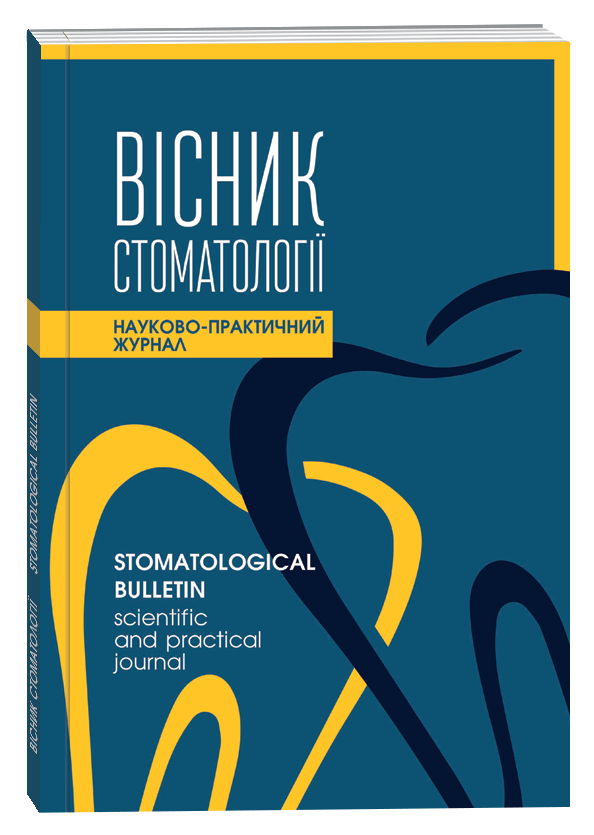CLINICAL EVALUATION OF DIRECT RESTORATION USING INTRACANAL PINS AT LONG-TERM FOLLOW-UP
DOI:
https://doi.org/10.35220/2078-8916-2022-43-1.4Keywords:
direct restoration, complicated caries, intracanal pins, restoration of the crown part of toothAbstract
To date, the destroyed crown part of the tooth can be restored by direct, indirect or combined methods. Each of these methods has its own advantages and disadvantages. Direct restoration makes it possible to replace a defect in the crown part of the tooth in one visit immediately after root canal obturation and prevent the development of complications in the immediate and long-term follow-up periods. Purpose of the study. The aim of the work was to compare the clinical efficacy of direct restoration of devital incisors using intracanal pins in the immediate and long-term periods of observation. Research methods. To achieve these goals, the restoration of devital incisors was carried out using three types of intracanal pins. Three clinical groups were formed depending on the type of construction. Each group consisted of 20 patients. In patients of the first group, the crown part of the tooth was restored using “Vitaplant” metal anchor pins (Ukraine) fixed on glass ionomer cement modified with FUJI plus composite (Japan, GS) and “Esthet X” photopolymer material (Great Britain, Dentsply). Direct restoration of the crown part in the second group was performed using photopolymer material “Est-3” (Ukraine, Esta) and fiberglass “PASS” pins (Ukraine, Esta), fixed on a composite cement of double hardening “CAPO” (Ukraine, Estha). The third group consisted of patients in whom the crown parts of the incisors were restored using glass fiber pins from J-dental (USA, J-dental), which were fixed on a double-hardening composite “Calibra” (Great Britain, Dentsply Sirona) and photopolymer material “Esthet X” (Great Britain, Dentsply Sirona). The assessment of the performed direct restoration of the crown part of the tooth was carried out clinically according to generally accepted criteria. The anatomical shape, marginal adaptation, surface roughness of the restoration, the presence of marginal staining, color matching, secondary caries, and the condition of the contact point were studied. These criteria were evaluated on the day of restoration, 6, 12 months, two, three and five years after the restoration of the crown part of the tooth. Conclusions. The results of a clinical study indicate the need to use elastic pins as intracanal structures during direct restoration of the coronal part of devital incisors.
References
Борисенко А.В., Семонова І.С. Тенденції розповсюдженості та інтенсивності ускладнених форм карієсу. Сучасна стоматологія. 2018. № (3). С. 15–17. DOI: 10.33295/1992-576X-2018-3-15-17.
Петрушанко В.М., Скрипник М.І. Відновлення коронок зруйнованих зубів за допомогою скловолоконних штифтів із застосуванням для їх фіксації рідкотекучого фотополімерного композитного матеріалу. Український стоматологічний альманах. 2017. № (4). С. 20–22.
Biomechanical Evaluation of a Tooth Restored with High Performance Polymer PEKK Post-Core System: A 3D Finite Element Analysis / L. Ki-Sun et al. BioMed Research International. 2017. № 2. Р. 1–9. DOI: 10.1155/2017/1373127.
Порівняння ефективності застосування скловолоконних та металевих штифтів для відновлення коронкової частини зуба / В.М. Петрушанко та ін. Вісник проблем біології і медицини. 2019. № 153. С. 201–204. URL: http://nbuv.gov.ua/UJRN/Vpbm_2019_4%281%29__50.
D’Arkandzhelo K. Restoration of endodontically treated teeth using fiberglass pins. URL: https://ligeya.com.ua/index.php/uk/publikatsiyi/11-publikatsiji-ua/58-restavratsiya-endodontichno-likovanikh-zubiv-zadopomogoyu-sklovolokonnikh-shtiftiv.
Baroudi K., Rodrigues J.C. Flowable Resin Composites: A Systematic Review and Clinical Considerations. Journal of Clinical and Diagnostic Research. 2015. V. 9 (6). Р. ZE18 – ZE24. DOI: 10.7860/JCDR/2015/12294.6129.









